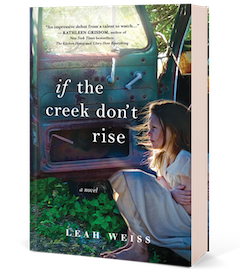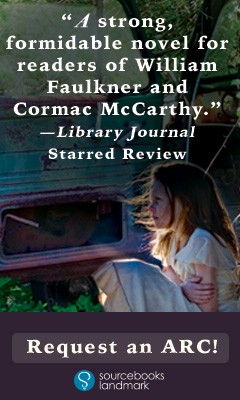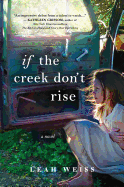If the Creek Don't Rise
by Leah Weiss
Set amid the jarring poverty of 1970s Appalachia, Leah Weiss's inspiring debut novel is steeped in atmosphere, ingenuity and heart. If the Creek Don't Rise is Sadie Blue's story, told from the perspective of a cast of fascinatingly robust characters who populate the downtrodden North Carolina town of Baines Creek.
Sadie, pregnant and newly married to Roy Tupkin, has experienced hell and heartache over her 17 years. Abandoned by her mother as an infant, orphaned when her father died when she was an adolescent, Sadie lived with her cold, curmudgeonly grandmother, Gladys Hicks, until she tied the knot with Roy only days prior to the novel's opening. And so far, her honeymoon has consisted of violent beatings and berating tongue-lashings. "The face in the cracked mirror shows another loose tooth, a split lip, and a eye turning purple. I don't see me no more in that slice of looking glass. It's a strange feeling thinking the face in the mirror is somebody else." The townsfolk aren't blind to Sadie's struggles, and most pity her, but feel there is nothing they can do to intervene. If they try, it will only make Roy angry and drive him to beat her even more. Others look at Sadie in disdain and think she is reaping what she sowed for taking up with Roy in the first place.
Despite the evil treatment at the hands of her husband and the lack of help from the town, Sadie is filled with hope for her baby. She cooks and sings and helps others even less fortunate. Then, when Kate Shaw arrives in Baines Creek to fill the teaching vacancy in the one-room schoolhouse, Sadie finds more meaning for her life--an opportunity to learn to read, as well as a new friend. Sadie carries around a treasured and tattered country music magazine because it features her beloved Loretta Lynn, a successful woman who clawed her way out of a Kentucky holler much like Baines Creek. As Sadie tells Kate, "Miss Loretta is a miracle to me." The town preacher, Eli Perkins, has always read the article to her, but Sadie delights in the idea of reading the words for herself. Regardless of Roy, Kate assures Sadie, "If you want to read, you will read."
As Kate and Sadie's friendship blossoms, Kate is determined to give Sadie the tools to help herself. But Roy is filled with a dark evil; he's suspicious and resentful of Kate. Her good intentions may backfire and put Sadie and her unborn baby in more danger than ever.
In addition to the voices of Sadie, Kate, Eli, Gladys and Roy, Sadie's story broadens through the perspectives of her compassionate aunt, Marris Jones; Eli's hard-hearted, spinster sister, Prudence; Roy's friend Billy Barnhill, who harbors a not-so-secret love for Sadie; the wonderfully eccentric author Birdie Rocas; and Tattler Swan, a boy who's both observer and mouthpiece for Jerome Biddle, a kind, poetic man fiercely devoted to Sadie and Kate. Each character provides more substance to Sadie's story, and they also tell the tale of Baines Creek itself. The history, the diversity, the beauty and the pain of this Appalachian hamlet are sketched out through the lives--and unique voices--of the novel's 10 narrators. Readers will likely come away wanting more of at least one, if not all, of these colorful characters.
Weiss's vividly realized settings and well-researched regional touches (from moonshine to ginseng, coal mining to Mother Jones) ensure authenticity throughout the novel. But it's the dialogue--both internal and external--that stands out, rendering the mountains and hollers of Appalachia and those who call it home in distinct and remarkable tones. The contrast between uneducated, naïve but kind Tattler ("What started as a regular day of fishing turned into commotion that don't usually live here. Usually things are pretty much like they supposed to be, cept today") and educated, feminist Kate ("This protracted scene in primitive Appalachia--in the throes of another angry storm that refuses to end, when political assassinations and civil rights battles and the birth control pill change tomorrows down below--is timeless and tiring") reflect the author's careful awareness of the size of their worlds as well as their vocabularies and level of education. Weiss also manages to sneak in smart humor through expertly crafted exchanges between characters, like when Birdie is explaining to Kate that her crow is bringing her various items belonging to Roy:
" 'I hear you Birdie, although I find it impossible to believe the crows know what belongs to Roy. You have to admit, it sounds far-fetched.'
'Far-fetched or close-fetched, these here things is Roy's things, and the crows bring em.' "
Birdie may not know grammar, but her play with language is both funny and reflective of her broad knowledge beyond book learning. The educated, articulate Kate learns many lessons from the people of Baines Creek, as will readers. Weiss's attention to these kinds of details make If the Creek Don't Rise an engaging page-turner and the characters who populate those pages realistic enough for readers to passionately connect with, whether through an empathetic enjoyment, a delightful fascination or a raging disdain.
If the Creek Don't Rise is a satisfyingly complete novel, but it also manages to leave Weiss room to return if she chooses. With its bewitching residents and rugged landscape, a journey to Baines Creek is a trip worth taking, and Weiss is likely to find many readers eagerly willing to travel with her again. --Jen Forbus








